Marketing teams, desperate to access a single unified profile of the customer, are rushing out to buy Customer Data Platforms (CDPs).
Five years ago, CDPs seemed like the right answer to the problem, and more than a billion dollars has been invested in CDP companies since then. But times have changed. Technology has evolved. The problem is no longer data collection (in fact, we’re drowning in more data than ever). Rather, it’s shifted to: How do we actually access and activate that data? 🤔
What we can learn from those who did buy CDPs, is that CDPs have not delivered on their promises. Instead, data-forward companies are switching to an alternative solution that costs far less and delivers value much faster: Activating their data warehouse.

WTF is a CDP and why do marketing teams buy them?
A Customer Data Platform (CDP) is an all-in-one platform built for marketing teams that:
- Collects and ingests data from different sources (online and offline channels)
- Unifies data across many sources into a single customer profile
- Activates data across channels and marketing tools (display, direct mail, email, mobile)
Well, that was the dream anyway; the reality is no true all-in-one solution exists. Even inside the CDP category, many are focused on different areas. For example, Twilio Segment is stronger on tag management, whereas Amperity is more of a vertical solution providing more analytics for retail.
Nowadays, every marketing tool is claiming to be a CDP. Sure, they are storing increasing amounts of customer data, but they don’t have the full picture of the customer because marketing automation and support systems are still disconnected and have limited activation capabilities. 🚫
The number one reason why marketing teams are rushing out to buy CDPs is to get a unified view of their customer, with 63% of marketers saying that unifying data is their key challenge. They know that building a unified view of the customer will enable them to run better campaigns with richer data to drive more ROI. And they believe that an off-the-shelf solution will enable them to do this faster (and without being dependent on data and IT teams).
But these promises haven’t come to fruition.

Spoiler alert: CDPs are not living up to their promises
CDPs promised us some amazing things 👇
- Better marketing ROI
- An auto-magically unified customer profile without engineering
- Trusted customer data
Like most promises that sound too good to be true – it was. 😔 Fast-forward about 5 years since CDPs came on the scene, and only 1% of companies are actually meeting their current and future needs with CDPs (Forrester 2022).
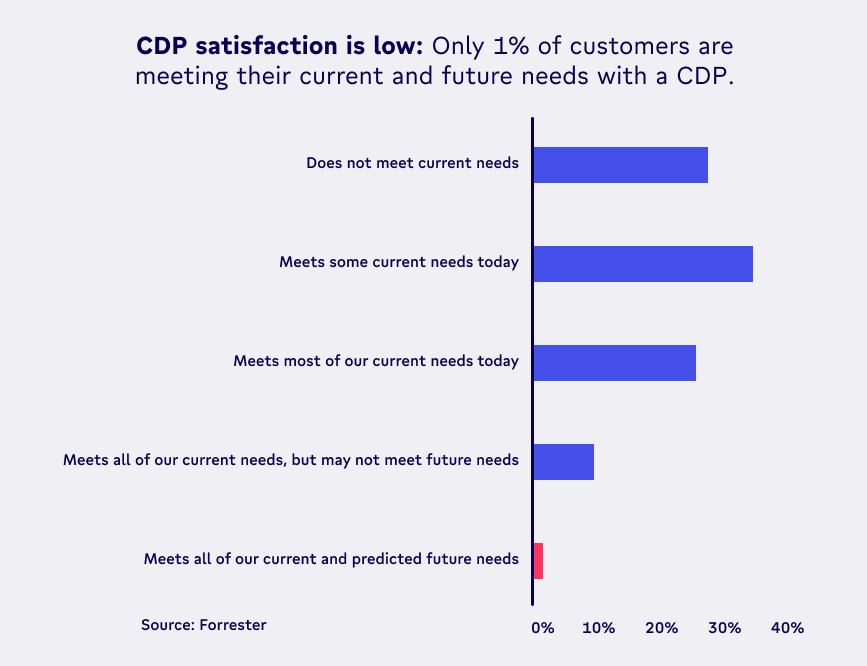
So, what can we learn? And why haven’t CDPs lived up to their promises? Let’s bust some CDP myths. 👊
#1 CDPs are not the single source of truth
CDPs claim to be the single source of truth for customer data, but they do not (and cannot) replace data warehouses. Why? Simply because CDPs don’t have all the customer and company-level information to be a complete source of truth for analytics. ⭐Instead, data collected by CDPs is copied to the data warehouse to power trusted analytics, instantly diluting the CDPs' promise of a “single source of truth.” Whilst some CDPs are now supporting importing data from the data warehouse, doing so results in additional data latency and still doesn’t solve the fact that the CDP is still just another silo of data. Due to this fragmentation, data inside the CDP is not as trusted or fresh as in the data warehouse.
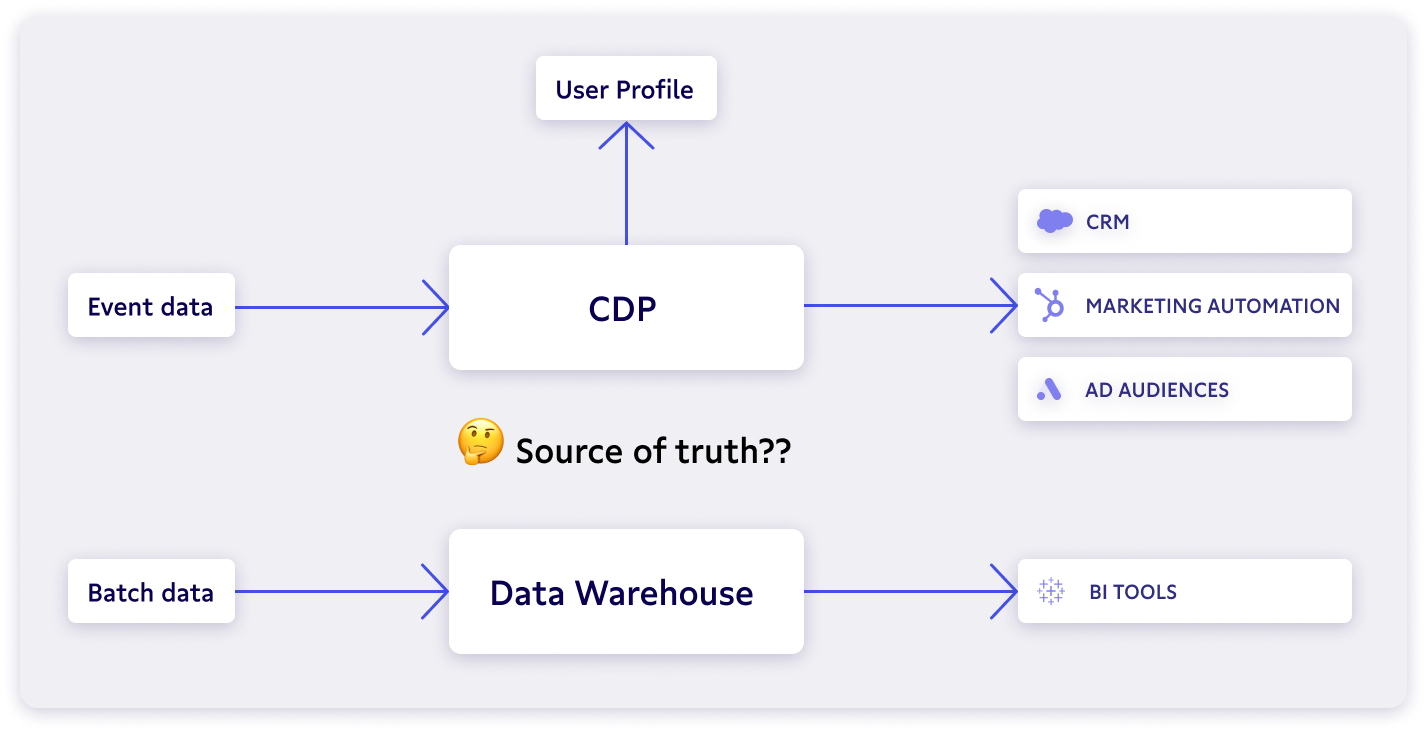
#2 CDPs offer limited flexibility and control
CDPs are a black box when it comes to how they transform and unify customer data. ⬛ And it’s not possible to generate a unified view of your customer without encapsulating the custom entities, relationships, and business objects that are unique to your business.
For example, Segment Personas has only two core business entities: Users and accounts. But in reality, modern companies have many of their own unique entities and hierarchies that don't fit into the standard "users" and "accounts" categories. For instance:
- B2B companies like Figma have organizations and teams, where users can be included in multiple teams.
- B2C companies like Skims have users, orders, subscriptions, etc.
CDPs have event-driven architectures, and importing custom data on your user often requires data to come in via an event structure. Unfortunately, this doesn’t always make sense when you’re dealing with aggregate analytics and makes it difficult to change historical data (e.g. if a user changes their team membership).
#3 Reliance on engineering and long time-to-value
CDPs promised fast ROI and self-service data, but the reality is very different. In addition to their expensive price tag, CDPs require a significant initial investment of engineering time and resources to set up. 🫰 When buying a legacy CDP, you're also forced to evaluate everything upfront because you're locked into a single platform. With months before you realize any value from activation and over 75% of CDP projects currently running over schedule, you're posing a huge risk to your investment. 😬
Many companies also underestimate the ongoing engineering resources needed to maintain a CDP. CDPs provide overlapping functionality to many of the data and engineering tools within the organization, meaning that engineering teams need to integrate CDP-specific data workflows into existing tools or add additional staff dedicated to managing the CDP.
Why you don’t actually need a CDP (if you have a data warehouse)
The goals of a CDP are still very relevant today – but are all-in-one CDPs the right solution?
CDPs emerged when marketing teams needed a way to collect their customer data, build unified customer profiles, and activate that data across different marketing channels. They attempted to solve this problem by having their own database for data collection, but in the process, they just created another silo of data.
Since then, other data technologies like data warehouses have advanced in scale and sophistication, while simultaneously getting significantly cheaper. Most growing companies are already investing heavily in data warehouses to power analytics and reporting, so is it still necessary to buy a CDP?
Let’s break it down. Companies typically buy CDPs for data collection, transformation, and activation.
- Data Collection. Engineering and Data teams have already set up robust data collection to collect vast quantities of behavioral (e.g. product, web analytics), operational (CRM), and transactional data (orders, subscriptions) on customers. These are either being streamed directly into your data warehouse (in the case of behavioral data) or engineering teams have built ETL (extract-transform-load) pipelines to extract this data from various sources and consolidate it in the data warehouse. Either way, each tool only has a fragmented view of the customer, and the data warehouse is the only place these silos are broken down.
- Data Transformation. Once the data is in the warehouse, data teams are already cleaning, joining, enriching, and flattening this data to make it consumable by analytical tools. For example, data teams need to unify many different tables of customer data across the organization in order to break down Customer Lifetime Value (CLV) by each individual customer ID.
So the collection and transformation pieces are already happening inside your organization – and the data warehouse has emerged as the most complete single source of truth for customer data. Today, however, the most common destination for this single source of truth is a dashboard. But dashboards are where data goes to die, because actually activating those insights still requires complex pipelines and engineering effort.
This is where warehouse-native data activation comes in. 🦸
Read more about why marketers should care about the data warehouse.
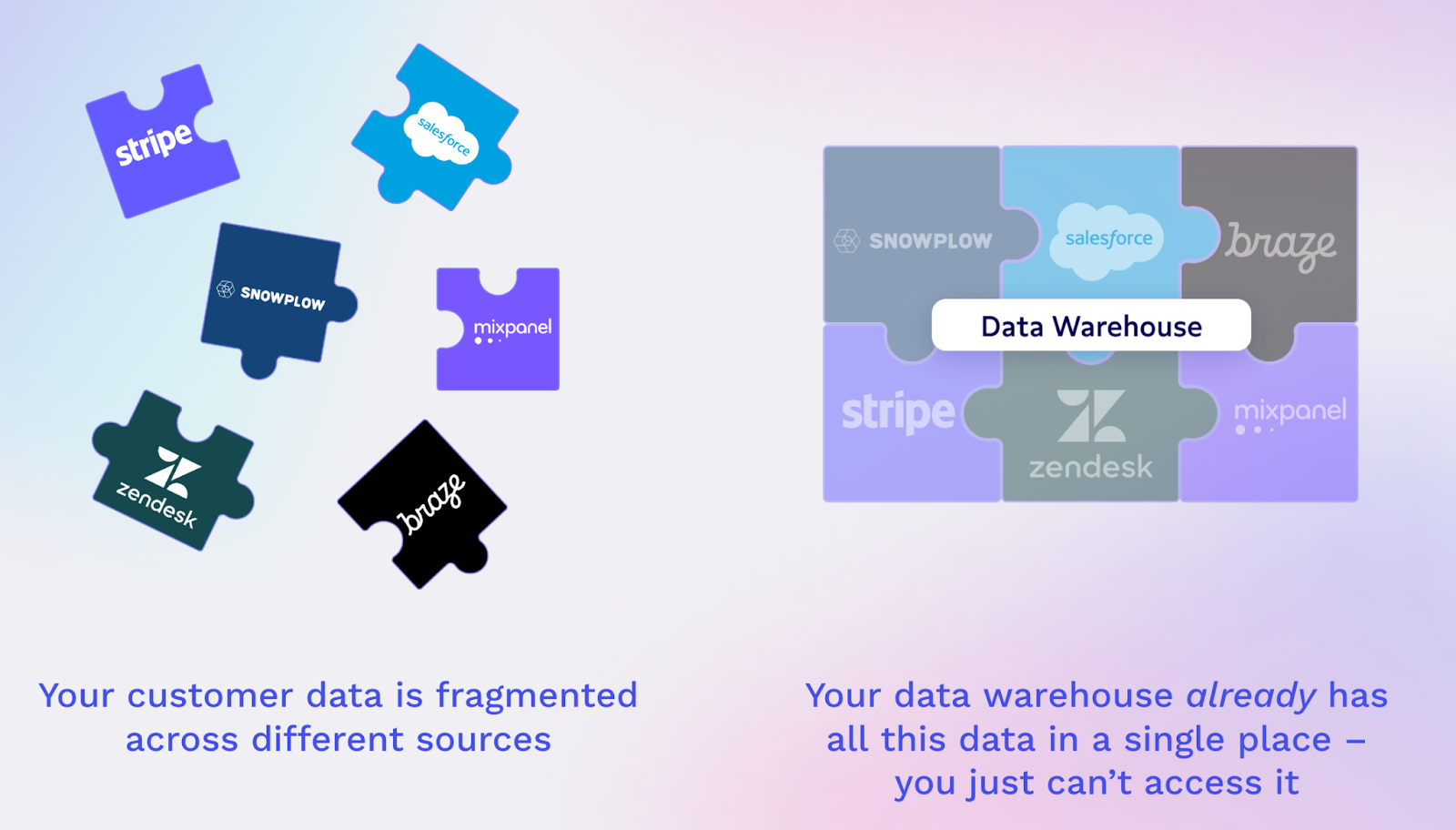
Data Activation is the missing piece 🧩
Data activation is the missing piece needed to connect the data collection and transformation efforts of the data team and make that data accessible to marketing teams to activate across all their channels. Warehouse-native data activation tools like Census enable marketers to unlock data directly from the warehouse – all without needing to know SQL. These warehouse-native activation tools enable marketers to 👇
- Sync customer attributes and lists from their data warehouse into “systems of action” such as Salesforce Marketing Cloud, Marketo, and Hubspot, and update them in real-time as the data is transformed. This pattern is known as reverse ETL.
- Build dynamic customer (and other entity) segments by filtering across trusted data models from the data warehouse and syncing them to all their advertising and marketing automation platforms from a single place.
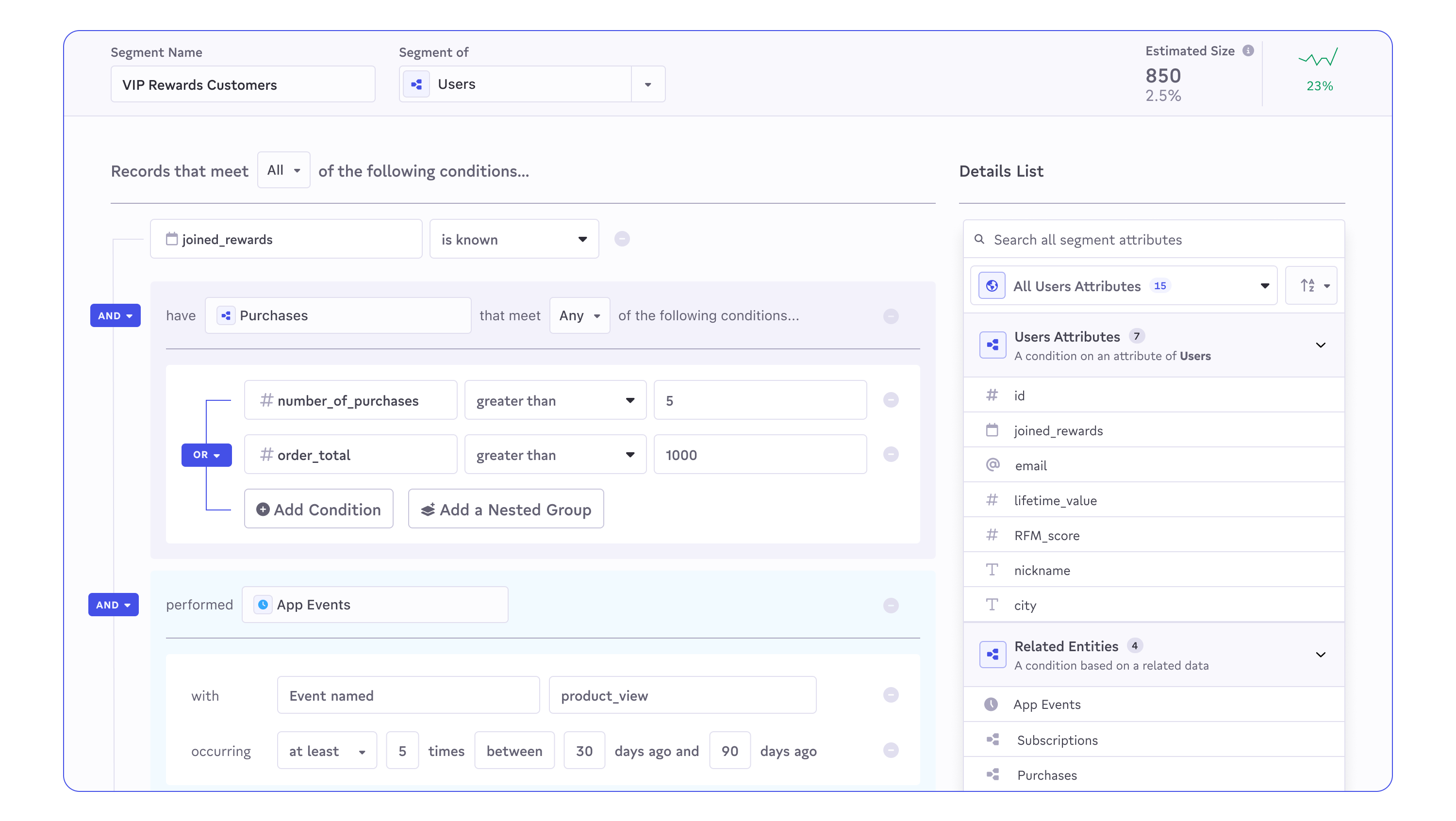
The Composable CDP: Bridging the gap between marketing and data teams 🤝
This alternative approach to a CDP is known by a few names: Composable CDP, unbundled CDP, headless CDP, etc. Although the name might differ depending on who you’re talking to, they are all ultimately saying the same thing: Use your data warehouse as the source of truth for customer data, and activate data where it already lives.
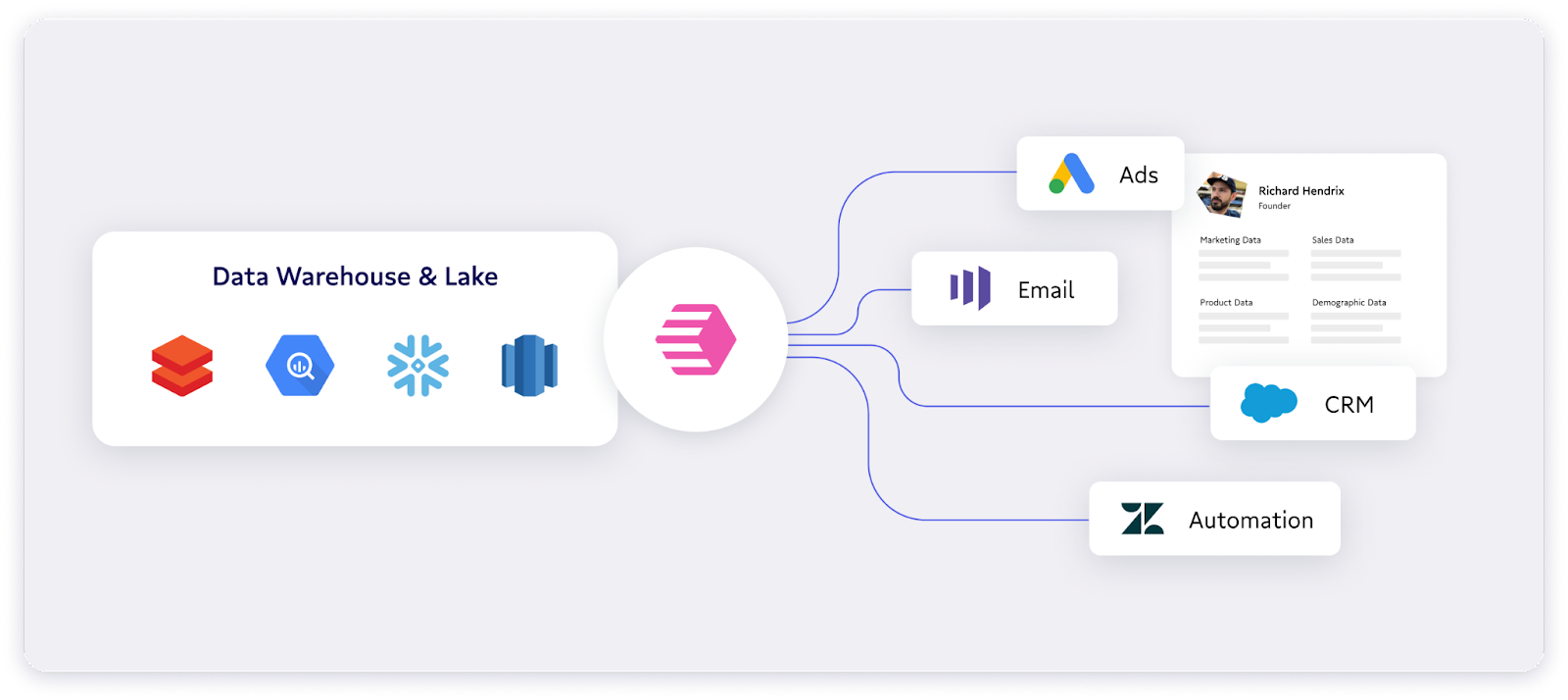
Warehouse-native data activation tools bridge the gap between marketing teams and data teams. 🌉 They allow data teams to define a set of trusted underlying tables or business entities that marketing teams can then use to sync customer attributes, or combine to build dynamic segments of users. In fact, tools like Census fundamentally change the way data and marketing teams collaborate to make marketing teams more agile.
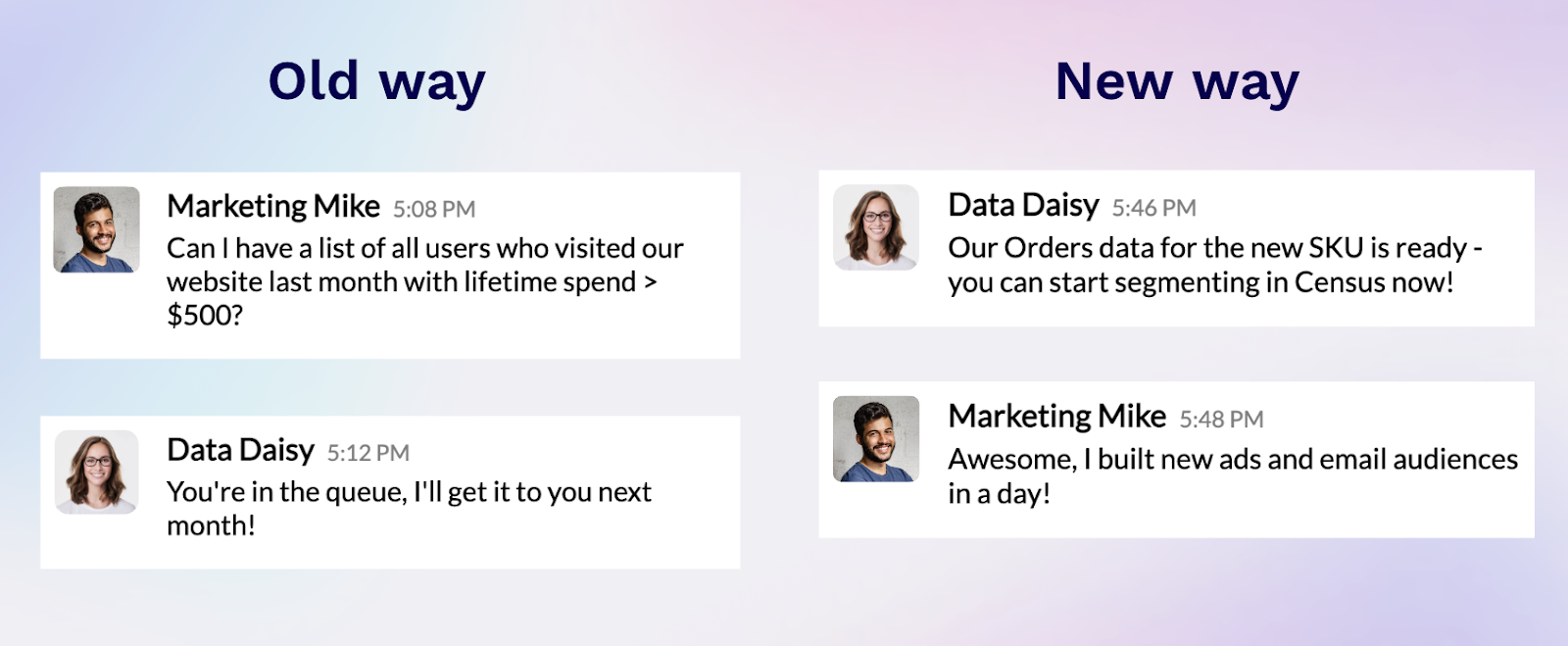
What about real-time use cases?
Up until recently, the biggest limitation of the data warehouse was the inability to perform real-time, high-speed use cases. Warehouses were designed for batch processing with high accuracy and scalability, but as a result, they were too slow for use cases like geotargeting and cart abandonment.
That meant that businesses had to implement their real-time use cases without the data warehouse by building a separate fast path, through custom infrastructure and event buses, CDPs, or iPaaS — all with painful limitations such as lack of scalability, data silos, and low adaptability. Modern business teams want to leverage the data warehouse to power their operations, but warehouse latency was one of the last barriers blocking adoption.
Last year, Census introduced Live Syncs to tear down the latency barrier. Live Syncs activate data from data warehouses in single-digit seconds, enabling companies to use the same data infrastructure for all use cases at any latency. The best part is, Live Syncs can be 100x faster and 100x cheaper to operate than traditional Reverse ETL, making real-time use cases more easily accessible to every business.
What are the benefits of using your data warehouse as a CDP?
A true single source of truth for customer data
While legacy CDPs on the market only give you a partial copy of your customer data, Census integrates with your data warehouse to provide you with a complete view of ALL your customer data. With this 360-degree view, organizations can easily leverage data from all sources, including POS systems, data science models, and even offline data to get a comprehensive understanding of their customers.
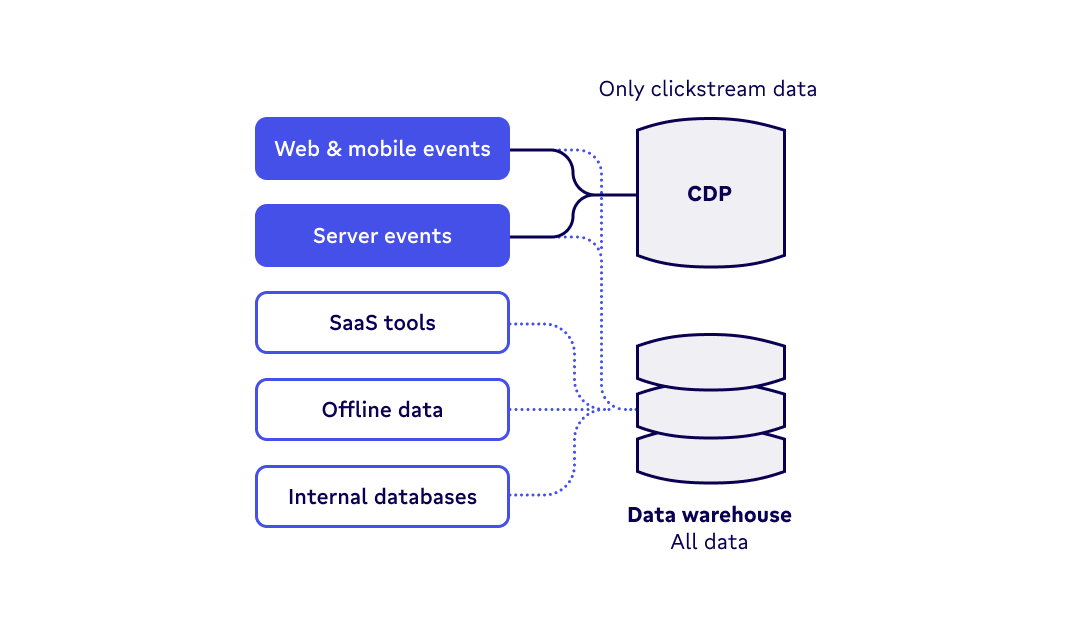
Faster Time-to-Value
CDPs are expensive. Like really, really expensive. 💰 This cost might be justified since it’s an all-in-one solution, but if you’re dropping a big chunk of change on a CDP, you need to be able to justify the value. And when you buy a legacy CDP, you have to think about everything before making your purchase because once you're locked into the platform, it’s game over. 🔒
On top of a long and difficult onboarding process, you won't be able to run any campaigns for months. However, with Census, organizations can connect to their warehouses and activate existing customer data so they can launch campaigns in minutes (literally) instead of waiting months.
More control and flexibility
CDPs that follow a legacy model limit customer data to a rigid structure. This might appear efficient at first, but businesses come in all shapes and sizes, meaning they require much more flexibility than what these CDPs can offer.
Data warehouses, on the other hand, have the ability to store and query relational data of any kind, making them ideal for organizations with complex needs. For example, data warehouses can represent relationships between users and entities like accounts, teams, workspaces, or devices. So, when it comes down to it, data warehouses provide organizations with the infinite flexibility needed to support even their most complicated use cases.
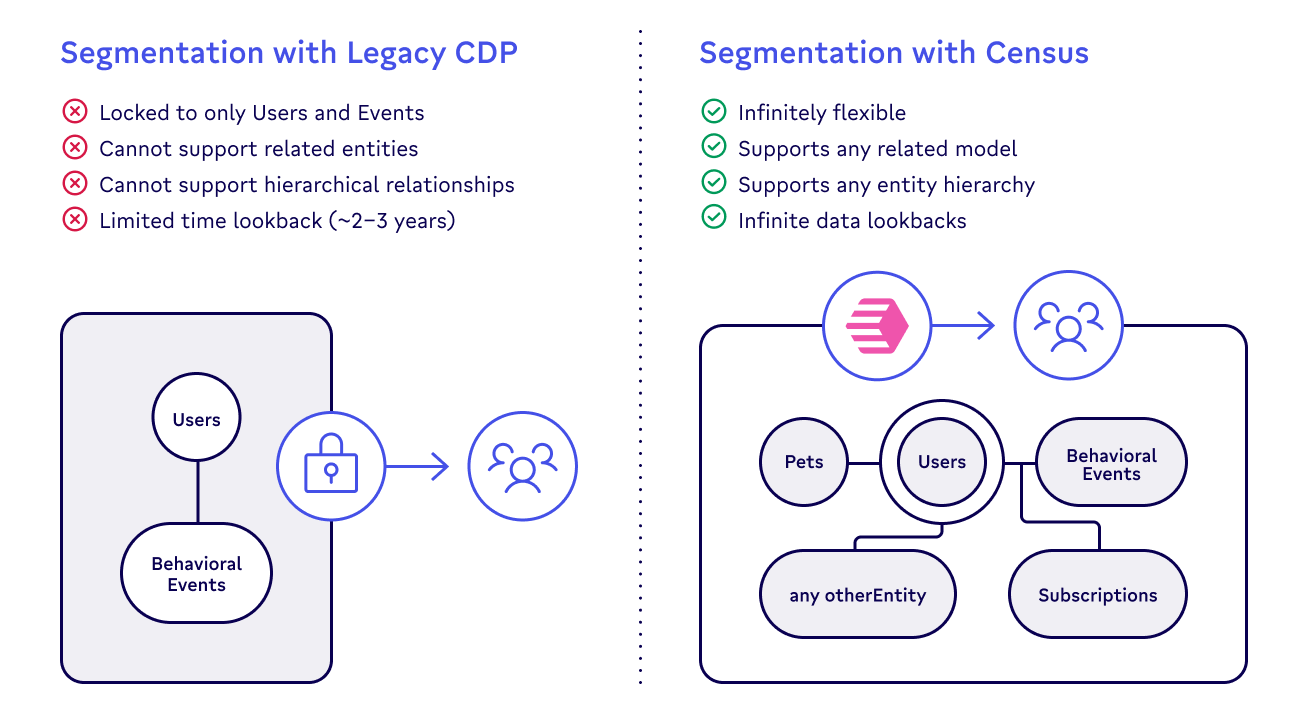
The future of the CDP IS the data warehouse 🔮
Every company should invest in a customer data platform. That’s not even a question. The real question is two-fold: Do you invest crazy amounts of money into an all-in-one solution? Or do you go for a more flexible approach that delivers value today, using warehouse-native data activation to create your own composable CDP?
Regardless of what you choose, there’s no denying that when it comes to the future of the CDP, the tailwinds are heading in the direction of the data warehouse. ✈️ CDP vendors like Twilio Segment and mParticle have recognized this by recently announcing their own versions of “reverse ETL connectors”, meaning that even they are acknowledging that the current CDP is incomplete. Customers need to enrich and activate data from the warehouse, and these now “legacy” CDP platforms were not designed natively for the data warehouse. Any attempt to “slap on” reverse ETL will be an afterthought.
The rise of the data warehouse as the single source of truth paired with warehouse-activation tools like Census takes away the need for organizations to invest in expensive all-in-one CDP solutions that don’t provide time-to-value. With data activation and reverse ETL democratizing access, the data warehouse is best positioned to become the system of customer record that powers not just your marketing technology, but the entire business operations of the company.
Learn more about how Census can help you activate the place your customer data already lives — the data warehouse. Book a demo with one of our product specialists to see how we can help you build granular segments, and sync customer data to all your marketing and advertising tools, without any code. 💪


















